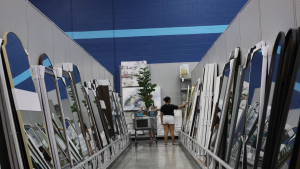U.S. consumer prices increased by the most in five months in June amid higher costs for some goods, suggesting tariffs were starting to have an impact on inflation and potentially keeping the Federal Reserve on the sidelines until September.

Softening demand as consumers hunker down, however, is limiting price increases for services like airline fares and hotel and motel rooms, keeping underlying inflation muted for now. That trend, if sustained, could ease concerns of a broad-based rise in price pressures from tariffs.
Nonetheless, economists generally expect the tariff-induced rise in inflation to become more evident in the July and August CPI reports, arguing that businesses were still selling merchandise accumulated before President Donald Trump announced sweeping import duties in April. They also noted that when Trump slapped tariffs on washing machines in 2018, it took several months for the duties to show up in the inflation data.
Trump last week announced higher duties would come into effect on August 1 for imports from a range of countries, including Mexico, Japan, Canada and Brazil, and the European Union.
“Inflation has begun to show the first signs of tariff pass-through,” said Ellen Zentner, chief economic strategist at Morgan Stanley Wealth Management. “While services inflation continues to moderate, the acceleration in tariff-exposed goods in June is likely the first of greater price pressures to come. The Fed will want to hold steady as it awaits more data.”
The CPI increased 0.3% last month after edging up 0.1% in May, the Labor Department’s Bureau of Labor Statistics said on Tuesday. That gain was the largest since January, and also reflected higher rental costs. Gasoline prices rebounded 1.0% after four straight monthly declines.A column chart titled “Monthly change in US Consumer Price Index” that tracks the metric over the last year.
Food prices rose 0.3%, matching the increase in May. Grocery store prices also advanced 0.3%, lifted by a 1.4% increase in the costs of nonalcoholic beverages and 2.2% jump in coffee prices, likely because of higher import duties.
Food prices rose 0.3%, matching the increase in May. Grocery store prices also advanced 0.3%, lifted by a 1.4% increase in the costs of nonalcoholic beverages and 2.2% jump in coffee prices, likely because of higher import duties.
Fruits and vegetables cost 0.9% more while beef prices jumped 2.0%. But eggs were 7.4% cheaper as an avian flu outbreak abated. The cost of food consumed away from home rose 0.4%.
In the 12 months through June, the CPI advanced 2.7% after rising 2.4% in May. Economists polled by Reuters had forecast the CPI would climb 0.3% and rise 2.6% on a year-over-year basis.
The U.S. central bank tracks Personal Consumption Expenditures (PCE) Price Index data for its 2% target. The Fed is expected to leave its benchmark overnight interest rate in the 4.25%-4.50% range at a policy meeting later this month. Minutes of the central bank’s June 17-18 meeting, which were published last week, showed only “a couple” of officials said they felt rates could fall as soon as the July 29-30 meeting.
CPI inflation readings came in on the low side in February through May, leading to demands by Trump for the Fed to lower borrowing costs. Trump persisted on Tuesday, writing on his Truth Social media platform, “Consumer Prices LOW. Bring down the Fed Rate, NOW!!”
Stocks on Wall Street were mixed. The dollar rose against a basket of currencies, hitting a 15-week high versus the Japanese yen. U.S. Treasury yields rose.
TAME UNDERLYING INFLATION
Excluding the volatile food and energy components, the CPI rose 0.2% in June. The so-called core CPI edged up 0.1% in the prior month. Despite the moderate gain, there were some solid increases in tariff-sensitive goods. Prices of household furnishings and supplies shot up 1.0%, the largest advance since January 2022, after climbing 0.3% in May. There was a record 4.2% jump in the prices of window and floor coverings and other linens.
Prices for appliances surged 1.9%, the biggest rise since August 2020, while the cost of apparel rebounded 0.4%. Sporting goods prices accelerated 1.4% while toys vaulted 1.8%, the most since April 2021. But those rises were partially offset by a 0.7% decline in the cost of used cars and trucks. New motor vehicle prices fell 0.3% for a second straight month.
Core goods prices rose 0.2% after being unchanged in May.
Owners’ equivalent rent of primary residence rose 0.3%, but the cost of hotel and motel rooms declined 3.6%. Airline fares dipped 0.1%. Healthcare costs increased 0.5%, driven by a 1.3% rise in dental services, which was the biggest gain in three years. There were also increases in hospital services and prescription medication.
The costs of services excluding energy services increased 0.3% after gaining 0.2% in May.
A slowing labor market, which is curbing wage growth, is also contributing to keeping services inflation in check. The overall core CPI inflation increased 2.9% in the 12 months through June after rising by 2.8% for three straight months.
“If the recent tariffs threatened for August 1 go into effect, it will take a few months for that additional boost to inflation to be felt in goods prices and will keep the Fed on the sideline unless the labor market takes a sudden turn for the worse,” said Ryan Sweet, chief U.S. economist at Oxford Economics.
Goldman Sachs is forecasting monthly core CPI inflation increases of between 0.3%-0.4% over the next few months, reflecting tariff-related increases in the prices of consumer electronics, autos and apparel. The investment bank expects limited near-term impact on core services inflation.
Based on the CPI data, economists estimate core PCE increased 0.3% in June after rising 0.2% in May. Core PCE inflation was forecast to have advanced 2.8% on a year-over-year basis last month after climbing 2.7% in May.
Those estimates could change after the release on Wednesday of producer price data, but some economists are hopeful that weakening demand will limit the scope for businesses to pass on tariffs to consumers.
“With consumers becoming more cautious about spending and the job market starting to lose some momentum, the recent price increases are expected to be gradual rather than dramatic,” said Sung Won Sohn, a finance and economics professor at Loyola Marymount University.
Reprinted from USA Today

